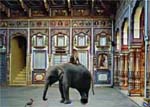 Faculty of fine arts’ Lichutola is now decorated with 26 photographs of two internationally acclaimed photographers — Tamas Dezso and Karen Knorr.
Faculty of fine arts’ Lichutola is now decorated with 26 photographs of two internationally acclaimed photographers — Tamas Dezso and Karen Knorr.
The ongoing exhibition is a part of the two-week international photography exhibition Chhobi Mela VI with this year’s theme ‘dreams’.
The two-week festival is running simultaneously at seven venues in the Dhaka city from January 21.
Tamas Dezso’s work, including 12 photographs, is titled ‘Here Anywhere’ while Karen Knorr’s work, titled India Song, includes 14 photographs put on display on the exhibition.
The photographs of the Puerto Rican photographer Karen show the opulence of India, especially the luxurious palaces built in the reign of Rajput and Mughal empires.
The photographer has captured archeologically significant buildings named Havelis and Mausoleums, which resemble the idea of power, deep-rooted in the cultural heritage of India.
Interestingly, images of animals such as tiger, monkey, peacock and cow and others in the photographs of those palaces draw attention of the viewers. But it is not clear whether the images of animals are digitally imposed or not.
One of the photographs, with a tag reading The Gatekeeper, Zanana, Samode Palace,’ showcases a white cow standing in the middle of a very artistically decorated room.
The presence of a cow into the once luxurious room perhaps connotes the religious connection between cow and the high caste of Hinduism.
The work of Hungarian photographer, Tamas Dezso, shows the rapid change in the name of urbanisation and modernisation taking place in society of Hungary. To portray the aggression of the so-called urbanisation in Hungary, Tamas captured images of buildings and nature.
One of his photographs shows a half-naked, bearded man standing in a dense forest and right beside him lays a huge log of a tree. The photograph is a good example of protest against deforestation. Another photograph showcases a toy lays close to a high-walled building of Budapest. The caption of the photograph says ‘Discarded toy on a site in the periphery of Budapest. Plots like this are often bought cheaply by real estate speculator hoping that with the modernisation of Budapest their value will go up. Budapest, Hungary, 2009.’




















